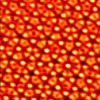Metallurgy and Surfaces group

Czochralski growth of a single crystal of an Al5Fe2 approximant of a decagonal quasicrystalline phase

View of a scanning tunneling microscope connected to one of the ultrahigh vacuum platforms (STM, AFM, LEED, XPS, UPS, MBE, SEM, SAM, EBSD)

Atomically resolved STM image (73x73 Å2) of the 5-fold surface of the icosahedral quasicrystal Al-Pd-Mn.
Last publications
- Magnetic properties of Ge, Re and Cr substituted Fe5SiB2
Matteo Casadei, Muhammad Maikudi Isah, Riccardo Cabassi, Giovanna Trevisi, Simone Fabbrici, Matteo Belli, César de Julián Fernández, Giuseppe Allodi, Vincent Fournée, Samuele Sanna, Franca Albertini
Journal of Alloys and Compounds, 2025, 1026, pp.180346. ⟨10.1016/j.jallcom.2025.180346⟩ - Atomic structure, chemical composition, and oxidation behavior of the (001) surface of Ni 2 In 3 intermetallic catalyst
Ahowd Youssef Alfahad, Vipin Kumar Singh, Emilie Gaudry, Julian Ledieu, Vincent Fournée, Peter Gille, Adrian Gardner, Paul Chalker, Ronan Mcgrath, Hem Raj Sharma
Physical Review Materials, 2025, 9 (3), pp.035801. ⟨10.1103/PhysRevMaterials.9.035801⟩ - Synthesis of fullerite (100) through epitaxy on a complex intermetallic surface
Wilfried Bajoun Mbajoun, Yu-Chin Huang, Girma Hailu Gebresenbut, Cesar Pay Gómez, Vincent Fournée, Julian Ledieu
Applied Surface Science, 2025, 679, pp.161217. ⟨10.1016/j.apsusc.2024.161217⟩
Presentation
The Metallurgy and Surfaces research group is conducting research on new intermetallic compounds by studying their structure and properties at the atomic scale, with a particular focus on their surface properties.
These intermetallics are characterized by a large unit cell containing from several tens to several thousands of atoms, arranged into interconnected high-symmetry clusters. Quasicrystals are the ultimate case. They are long-range ordered materials but they lack the translational periodicity characterizing usual crystals. They exhibit classically forbidden symmetries, such as 5-fold or 10-fold rotational symmetries. These complex intermetallics can be found in a large number of binary and ternary systems. Quasicrystalline structures can also occur as 2D oxides or in self-organized molecular thin films.
These materials can have remarkable surface properties (reduced wetting and friction, good corrosion resistance, low thermal conductivity, high catalytic activity and selectivity, etc.). They can find applications as coating materials, as reinforcement particles in composites or as new catalysts for the chemical industry.
Its research seeks for a fundamental understanding of the origin of these properties.
Its activities include:
• Metallurgy of complex intermetallics: synthesis of novel compounds, physical characterization, single crystal growth,
• Experimental investigations of their structure and properties using surface science methods under ultrahigh vacuum conditions (scanning tunneling microscopy, photoemission spectroscopy, low energy electron diffraction, scanning Auger microscopy, electron microscopy)
Research topics
New intermetallic compounds and single crystal growth
The field of intermetallics is extremely rich. It is believed that only a small fraction of existing compounds has been discovered so far: less than 50% of the binary compounds, less than 5% of the ternaries, and probably less than 1% of the quaternaries. Quasicrystalline phases and large unit cell crystals have already been discovered in more than one hundred different systems and the list is constantly growing.
The group is searching for new intermetallic phases, in particular in so-called push-pull systems. These are defined as ternary systems in which two binaries form intermetallic compounds while the third binary does not. Samples are produced by arc-melting, induction melting, sintering or by melt spinning. They are further characterized by differential thermal analysis, X-ray diffraction, or electron and optical microscopy. In favorable cases, large single crystals can be grown by the Czochralski pulling method or by flux. These single crystals are useful to perform surface science experiments and to measure intrinsic physical properties, either at IJL or through national or international collaborations (IRP PAC2S; European CMetAC).
Project:
IRP PAC2S (international associated laboratory between IJL and the Jožef Stefan Institute in Slovenia), 2019-2023.
Article:
Crystalline and electronic structures of the AlV2Sn2-x (x = 0.19) intermetallic compound, Boulet et al., Inorg. Chem.
Surfaces of novel intermetallic compounds
Determining the atomic and electronic structures is essential to understand and optimize the surface properties of these intermetallics. The group has developed an internationally recognized expertise in this field, combining experimental surface science methods and ab initio calculations using the density functionality theory.
Surfaces are investigated at the atomic scale to determine their structure, the surface plane selection mechanisms, the role of chemical bonds, the possible effects of segregation, etc. which lead to specific structure and surface properties.
Projects:
- European Integrated Centre for the Development of New Metallic Alloys and Compounds
- IRP PAC2S (international associated laboratory between IJL and the Jožef Stefan Institute in Slovenia), 2019-2023.
Articles:
- From Surface Structure to Catalytic Properties of Al5Co2(2-10) : a Study Combining Experimental and Theoretical Approaches, Chatelier et al., J. Phys. Chem. C, 2020
- Investigation of the (100) and (001) surfaces of the Al5Fe2 intermetallic compound. L. Boulley, D. Kandaskalov, M.C. de Weerd, S. Migot, J. Ghanbaja, S. Sturm, P. Boulet, J. Ledieu, E. Gaudry, V. Fournée.
App. Surf. Sci., 542 (2021) 148540
Thin films and interfaces
The surfaces of intermetallics are used as substrates for the growth of ultra-thin films. In some cases, it is possible to induce some symmetry elements of the substrate into the films and thus to obtain new materials that would not exist otherwise, like quasiperiodic single element metal overlayers or molecular films. 2D quasicrystalline oxide films can also form at the interface by dewetting an epitaxial oxide film grown on a metal substrate.
Interdiffusion can occur at the interface between a thin film and a metal substrate that can result in the formation of intermetallic compounds in the near-surface area, called surface alloying. It allows studying how these complex materials form interfaces with other more conventional ones. The wetting and friction properties also depend on the interfacial structure.
Projects:
- OXYQUASI
- European Integrated Centre for the Development of New Metallic Alloys and Compounds
- IRP PAC2S (international associated laboratory between IJL and the Jožef Stefan Institute in Slovenia), 2019-2023
- ANR NOUS
Thèses:
- 2018-2021, Catalina Ruano-Merchan (MESR)
- 2018-2021, Dominique Dubaux
Articles:
- Metastable Al-Fe intermetallic stabilised by epitaxial relationship. D. Dubaux, E. Gaudry, M.-C de Weerd, S. Sturm, M. Podlogar, J. Ghanbaja, S. Migot, V. Fournée, M. Sicot, J. Ledieu. Applied Surface Science, 533 (2020) 147492
- Two-dimensional square and hexagonal oxide quasicrystal approximants in SrTiO3 films grown on Pt(111)/Al2O3(0001). C. Ruano M., T. T. Dorini, F. Brix , L. Pasquier, M. Jullien, D. Pierre, S. Andrieu, K. Dumesnil, S. S. Parapari, S. Šturm, J. Ledieu, M. Sicot, O. Copie, E. Gaudry, and V. Fournée. Phyc. Chem. Chem. Phys., 24 (2022) 7253.
Interactions with the environment
Intermetallic phases exhibit properties of technological interest. Remarkable wetting and friction properties were identified in the group soon after the discovery of quasicrystals and were at the heart of some applications of these materials. The results highlighted unexpected correlations between wetting and friction and the electron density of states. Surface reactivity of these compounds is also investigated currently to understand the mechanisms of oxidation as well as for potential application in heterogeneous catalysis for the chemical industry, aiming to replace noble metals used for certain hydrogenation reactions for example.
Thesis:
Thiago Trevizam-Dorini, 2019-2022, Lorraine University of Excellence (LUE)
Articles:
- Catalytic properties of Al13TM4 complex intermetallics: influence of the transition metal and the surface orientation on butadiene hydrogenation, Piccolo et al., Sci. Technol. Adv. Mater., 2019, 20, 557–567.
- Non-wetting behavior of Al-Co quasicrystalline approximants owing to their unique electronic structures. K. Anand, V. Fournée, G. Prévôt, J. Ledieu, E. Gaudry. ACS Materials and Interfaces, 12 (2020) 15793–15801
Know-how
Synthesis
- Synthesis of novel intermetallic phases (arc melting, induction furnace, melt spinning, sintering) and single crystal growth (Czochralski, flux). Laue diffraction
- Preparation of single crystal substrates by ion bombardment and annealing (radiative or electron beam heating) under ultrahigh vacuum conditions
- Thin films deposition under ultrahigh vacuum conditions (metal thin films, surface alloying, molecular thin films and oxide thin films).
Characterization
- Surface structure determination by low energy electron diffraction (LEED) and scanning tunneling microscopy (STM)
- Physical chemistry of metal surfaces by photoemission spectroscopy (XPS, UPS)
- Topography, chemistry and structure of solid surfaces at the nanoscale under ultrahigh vacuum conditions (SEM, nanoSAM, EBSD) with the SCAN platform connected to the tube D.A.U.M.
Technology transfer
- Development of new composite materials for additive manufacturing technologies in collaboration with the technology research group ‘Materials and processes for additive manufacturing’. Several patents since 2009
Members
CNRS researchers
- Vincent FOURNEE
- Julian LEDIEU
- Muriel SICOT
Technical and support staff
- Gwladys LENGAIGNE
Post-doctoral researchers
- Wilfried BAJOUN MBAJOUN
PhD students
- Anthony ALHAYEK
- Vincent BOUCHER
- Dany SIHOM KWEKAM
- Abhirami SURESH
Emeritus
- Jean-Marie DUBOIS
Publications
Contact
Head of the group
Vincent FOURNÉE
vincent.fournee@univ-lorraine.fr
+33 (0) 3 72 74 25 08
Nancy-Artem
Institut Jean Lamour
Campus Artem
2 allée André Guinier - BP 50840
54011 NANCY Cedex
